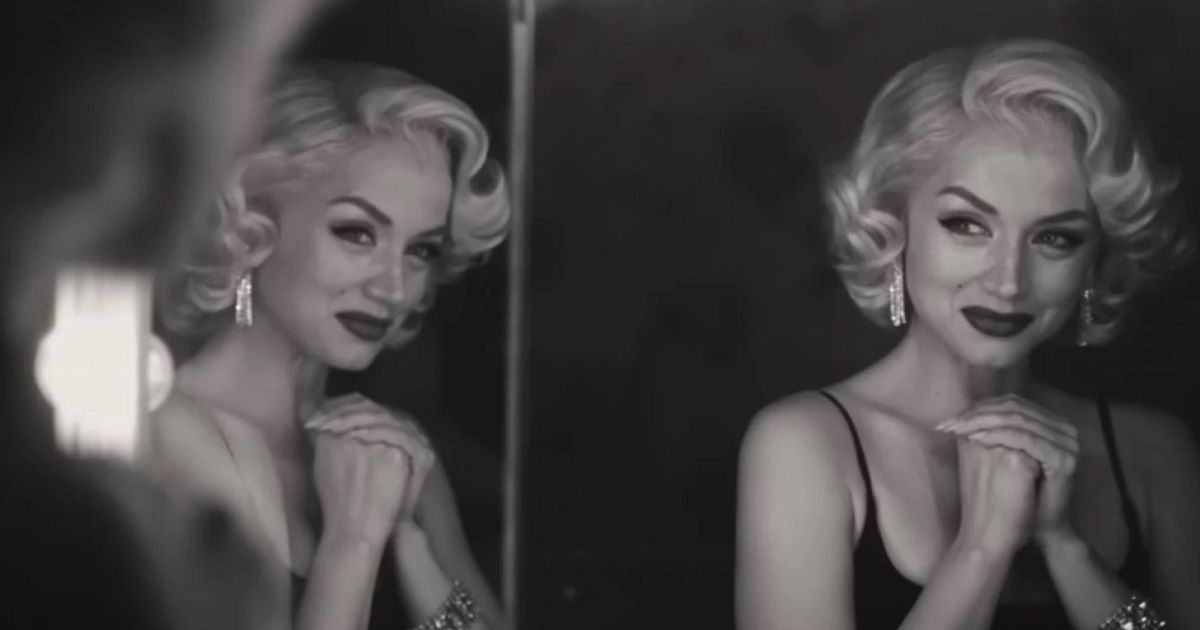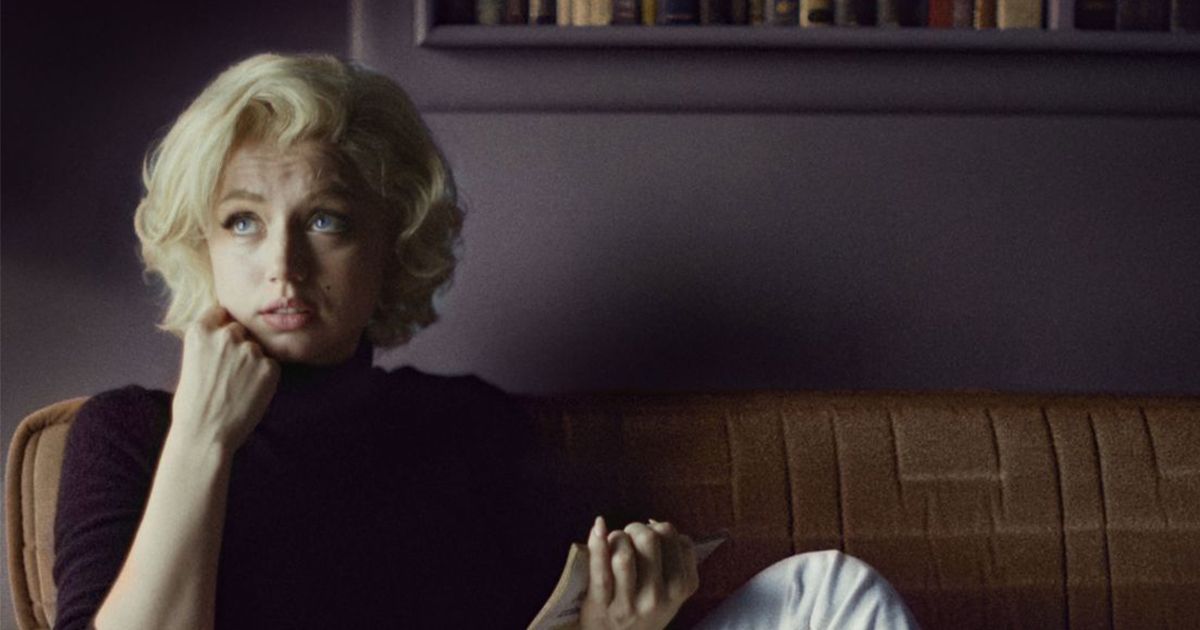Blonde star Ana de Armas has been candid about taking on the role of Marilyn Monroe in director-screenwriter Andrew Dominik’s hotly discussed new film. “Marilyn was the most famous person in the world,” de Armas once said. “But Norma, because of that, became the most invisible person in the world. And that’s the story we want to tell.”
And what a story.
Dreamy, hypnotic, and often indulgent, Blonde feels like one of those immersive art exhibits where attendees are surrounded by ethereal moving images of the work of Frida Kahlo or Van Gogh, and even Prince. Blonde is cinema. It may even be art. But moviegoers trained to experience the usual cinematic beats won’t find them here. That’s great. Nothing like shaking up the senses—to a point. And even though you never really want to take your eyes off this movie — or de Armas, who commands every frame she occupies (which is nearly all of them) — Blonde can be a little tricky to fully embrace. The film runs nearly three hours and occasionally feels like an extended therapy session sit-in. Basically, we’re watching Marilyn’s madness play out — from unresolved childhood trauma to her twisty psychological meanderings.
Surely, that’s the point, but even therapy sessions need a 10-minute break to catch one’s breath. Dominik’s modus operandi is clear: to truly “get” what Monroe experienced — in fact or fiction — one must walk through the fractured fairy tale of her life, which, we’re reminded repeatedly, was full of rotten apples, wicked antagonists, and a slew of personal demons.
Breathe. You’ll need to.
Re-imagining Marilyn Monroe's Story
Blonde is based on the fictional novel, “Blonde,” by Joyce Carol Oates. Publisher’s Weekly called the tome, “dramatic, provocative and unsettlingly suggestive.”
Dominik (Chopper, The Assassination of Jesse James by the Coward Robert Ford, Killing Them Softly) picks up the creative baton from Oates to re-imagine the life of one of Hollywood’s most celebrated icons—from her volatile childhood as Norma Jeane through her rise to stardom and romantic entanglements. It often blurs the lines of fact and fiction and explores the ever-widening split between Monroe’s public and private selves.
In addition to de Armas, the film stars Bobby Cannavale as “the ex-athlete,” no doubt a version of Joe DiMaggio, Monroe’s second husband. There’s also Adrien Brody in fine form as “the playwright” (that’s you, Arthur Miller, Monroe’s third husband), and Julianne Nicholson, who as Gladys, is a commanding presence early on as Marilyn’s beleaguered mother.
Xavier Samuel and Evan Williams play charmers Cass Chaplin and Eddy G. Robinson Jr., two adult children of famous stars who form a throuple with Marilyn in the film’s first half, which is as brooding as it is ethereal. The first 25 minutes introduce us to a young Norma Jeane, a child abandoned by her father and left in the hands of her volatile, alcoholic, and abusive mother. It’s harrowing to watch it play out, yet what makes the film so remarkably unique from the onset is Dominik’s choice to limit the use of audio effects. There’s no swell of music here—or there. We’re placed smack dab into the cyclone of a young child’s shattered life. From there, Cass and Eddy encourage the now-grown Marilyn to expand her horizons—personally with them and in showbiz.
But there’s always an emptiness to the Norma Jeane and it’s a direct result of her absent father and tortured past.
Of taking on the project, the director has said it was a little “like falling in love… I read the book in about 2002. It was something that stayed in my mind, but the major attraction was the opportunity to show how childhood trauma could affect an adult life.”
We witness it here throughout Norma Jeane’s life and as she rises to become the Marilyn Monroe we’ve all come to “know,” she remains haunted by the past, often a kind of walking gaping wound. Dominik fervently floats between black-and-white and color throughout the film to illuminate that madness. Some scenes find Marilyn in front of directors. What appears to be a “normal” shot, ends up becoming a sublime psychological aside from Marilyn herself. At one point, she cries: “You’re not him—you never were!” Surely, referring to her father. In another scene, she waxes philosophical: “After all, isn’t all love based on delusion?”
That may be a wink to everybody watching Blonde. The public’s unrelenting devotion to Marilyn isn’t based entirely on fact. Simply image. It recalls the allure of Princess Di. In each case, beyond the public image, there was a human being that nobody really knew.
“I’m not a star,” de Armas muses in the film, “I’m just a blonde.” And one of her best lines: “Some of them love Marilyn, some of them hate Marilyn. What’s that got to do with me?”
Dominik effectively captures that split between the image and the real person. Scenes often play out longer than tradition requires. And there’s a fascinating bit of claustrophobia at times as the director intentionally opts for close-ups and tight spaces, rather than the spaciousness of, well, freedom.
Norma Jeane didn’t have that, after all. All of it makes for a wild experience. And that’s exactly what Blonde is: an “experience.”
How the Actors Measure Up in Blonde
Born June 1, 1926, in Los Angeles, Norma Jeane Baker became the quintessential star. She lived periodically with her mother, Gladys, who braved a variety of mental illnesses. She was sent to the Los Angeles Orphans Home Society until she was 16 and at that point, married her first husband James Dougherty.
Blonde doesn’t root itself that deeply into Norma Jeane’s first marriage, opting instead to lean more heavily into the emotional tear between her parents. It then segues into tracking Norma Jeane’s rising star—first as a model, later in film roles like 1953’s noir thriller Niagara and eventually with her iconic roles in Gentlemen Prefer Blondes, How to Marry a Millionaire, and perhaps most famously, Billy Wilder’s The Seven Year Itch—that famous white dress scene and all. Dominik weaves through these major events with occasional nuance, even sidetracking into Marilyn’s trauma while filming the 1959 comedy Some Like it Hot.
Blonde teeters more than it should whenever it indulges in depicting graphical details of Marilyn’s travails. There are several POV shots from inside Marilyn’s vagina, particularly during a forced abortion. Another scene finds her braving her own drug-induced stupor while sitting on the bed of “the President” — President Kennedy — who forces her to fellate him. That, along with plenty of nudity, no doubt garnered the film’s NC-17 rating.
There are also several scenes where crowds of mostly men and male paparazzi hound her, triggering a vivid reminder of the terror of misogyny. These devices intentionally rattle the nerves, but it spawns a bizarre paradox. The filmmaker is condemning the brutality Marilyn encountered yet weirdly sensationalizes it.
Intentionally unsettling? Seems so.
Brad Pitt is one of the producers here. His confidence — and partial bank roll — give the outing forward momentum, and even if this bit of cinematic “art” is occasionally off-putting, it’s worthy of an investment.
Recently, de Armas received a 14-minute standing ovation during Blonde’s world premiere at the 2022 Venice Film Festival, so surely streaming audiences will dive in when the film hits Netflix on Sept. 28. The actress simply loses herself in the role.
Overall, the acting in Blonde is exceptional, with Brody, Samuel, and Williams standing out. In addition to de Armas, Nicholson may wind up with an award nod. She’s hauntingly effective as Norma Jeane’s mother.
It's been reported that Ana de Armas researched Marilyn Monroe—to the bone. And it shows. Of the icon, she’s said: “Her breathiness and her high pitch was a result of someone with no boundaries needing to let everyone in. She needed that closeness with people because she never had it before.”
That becomes the creative throughline in Blonde. Pieced together with everything else the actors and filmmaker serve up, we’re left with a mesmerizing, oftentimes bizarre house of Marilyn mirrors that you can’t quite fully escape.
Blonde premieres on Sept. 28 on Netflix.


